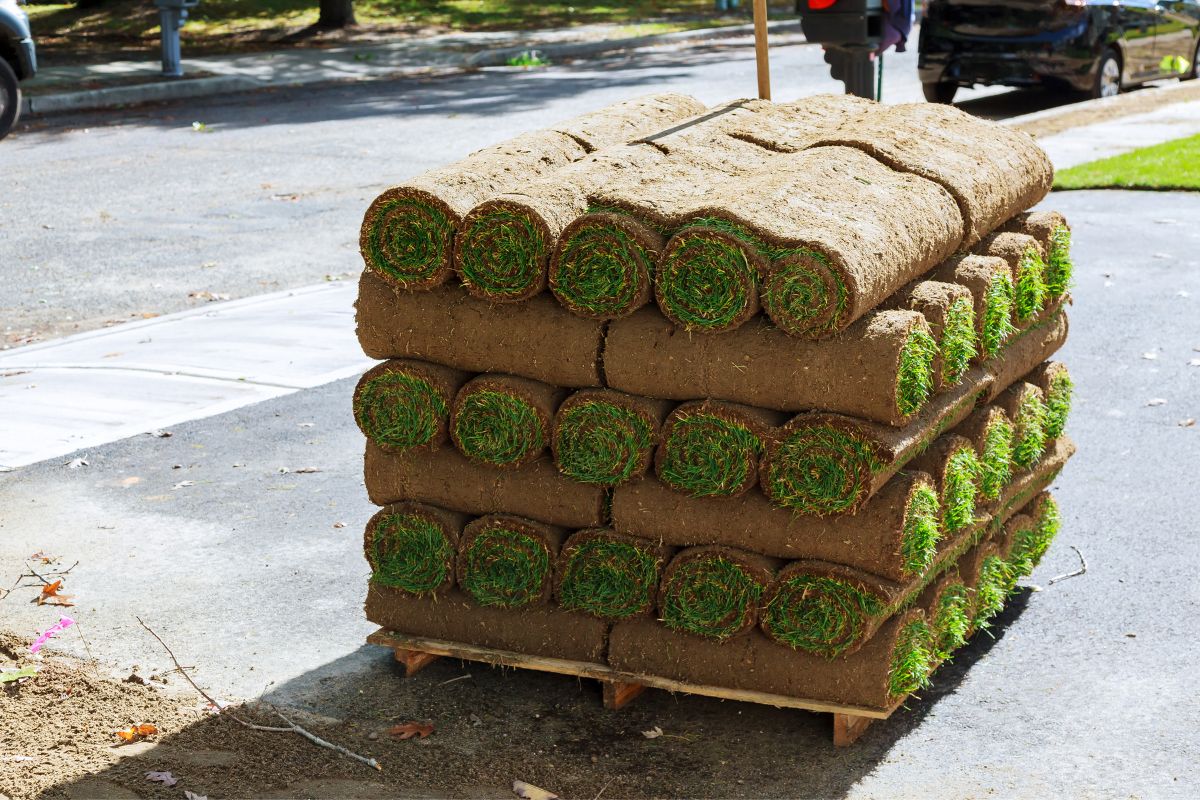Introduction
When it comes to landscaping projects or revitalizing your lawn, sod is a popular choice. Sod, also known as turf or grass, provides an instant green carpet for your outdoor space. However, one crucial factor to consider when working with sod is its weight. In this article, we will delve into the question: “How much does a pallet of sod weigh?” We’ll explore the factors affecting sod weight, its applications, and tips for handling it.
Understanding Sod and Its Uses
What Is Sod?
Sod is essentially grass that has been cultivated and maintained as a single piece. It’s usually grown on a specialized farm and then harvested as square or rectangular pieces. Sod is a popular choice for establishing a lush lawn or repairing damaged turf quickly.
Sod Applications
Sod has a wide range of applications, including:
1. Lawn Establishment
Sod provides an immediate, aesthetically pleasing lawn, which is particularly useful for new home construction or where quick results are desired.
2. Turf Repair
Sod can be used to repair patches of a lawn that have been damaged by various factors, such as pests, drought, or heavy foot traffic.
3. Erosion Control
Sod helps prevent soil erosion on slopes and other vulnerable areas.
Factors Affecting Sod Weight
Determining Sod Weight
The weight of a pallet of sod depends on several factors:
1. Sod Type
Different grass varieties have varying densities and moisture content, which can affect their weight.
2. Sod Thickness
Sod is available in various thicknesses, typically ranging from 1/2 inch to 1 inch. Thicker sod pieces will naturally weigh more.
3. Pallet Size
The size and type of pallet used to transport the sod also play a role in determining its weight. Standard pallet sizes are typically 4×4 feet or 4×8 feet.
4. Moisture Content
The moisture content in the sod can vary, affecting its weight. Wet sod will be heavier than dry sod.
Average Weight of a Pallet of Sod
How Much Does a Pallet of Sod Weigh?
On average, a pallet of sod can weigh anywhere from 1,500 to 3,000 pounds. This is a broad range, and the actual weight can vary significantly based on the factors mentioned earlier.
Let’s break it down further:
1. Sod Type
- Kentucky Bluegrass: 1,500 to 2,500 pounds per pallet.
- Bermuda Grass: 1,800 to 2,800 pounds per pallet.
- Zoysia Grass: 2,000 to 3,000 pounds per pallet.
2. Sod Thickness
- Thin Sod (1/2 inch): Lighter, closer to 1,500 pounds.
- Thick Sod (1 inch): Heavier, up to 3,000 pounds or more.
3. Pallet Size
- Smaller pallet (4×4 feet): Lighter than larger pallets.
- Standard pallet (4×8 feet): Heavier, closer to the upper weight limits.
4. Moisture Content
- Dry Sod: Lighter.
- Wet Sod: Heavier.
Handling and Transporting Sod
Tips for Handling Sod
Handling sod, especially when it’s on the heavier side, can be challenging. Here are some tips:
1. Use Proper Equipment
If you’re dealing with large pallets of sod, consider using equipment like a forklift or a pallet jack for easier transport.
2. Teamwork
Sod is heavy, so it’s best to have a team of individuals to help with lifting and laying it.
3. Plan Carefully
Measure your project area accurately to ensure you order the right amount of sod. Having excess sod can be costly and challenging to store.
Understanding Sod
Sod, also known as turf or grass rolls, is essentially a layer of grass and soil held together by roots. It is commonly used to establish or repair lawns quickly. Sod comes in different types, such as Bermuda, Zoysia, Kentucky Bluegrass, and Fescue, each with its unique characteristics and maintenance requirements.
The Dimensions of a Sod Pallet
Sod pallets vary in size and shape, depending on the supplier and region. Typically, a standard sod pallet is 450 square feet, covering an area of 18 feet by 25 feet. The dimensions can, however, differ, so it’s essential to check with your sod supplier to determine the exact measurements of their pallets.
Factors Affecting the Weight of a Sod Pallet
1. Sod Type
Different sod types have varying levels of density and thickness. This results in variations in weight. For example, St. Augustine sod is generally denser and heavier than Bermuda grass sod.
2. Soil Moisture Content
The moisture content of the soil within the sod can significantly impact its weight. Sod is typically harvested with some moisture to keep it healthy, but this moisture content can change over time and with environmental conditions.
3. Thickness
Sod thickness can also affect its weight. Thicker sod pieces will naturally weigh more than thinner ones. Some projects may require thicker sod for a more immediate and established look.
4. Soil Composition
The composition of the soil used in sod production can vary from one region to another. Some soils are denser and contain more moisture, which will contribute to a heavier pallet.
5. Local Climate
Local climate conditions can influence the weight of a sod pallet. For example, sod harvested during wet or rainy periods may be heavier due to increased soil moisture.
6. Sod Roll Size
The size of sod rolls can vary, affecting the number of rolls on a pallet and, consequently, its weight.
Average Weight of a Sod Pallet
The weight of a pallet of sod can vary widely, but as a rough estimate, a standard pallet of sod containing 450 square feet of sod can weigh between 1,800 to 2,400 pounds. This range takes into account the factors mentioned above, including the type of sod, its thickness, moisture content, and the local climate.
How Many Square Feet Is a Pallet of Sod
A standard pallet of sod typically covers an area of 450 square feet. This measurement is based on the common dimensions of sod pallets, which are usually 18 feet in length and 25 feet in width. However, it’s essential to note that pallet sizes may vary slightly depending on the supplier and region, so it’s a good practice to confirm the specific dimensions of the sod pallet with your supplier to ensure accurate coverage for your landscaping project.
How Much Does Sod Cost Per Square Foot
The cost of sod per square foot can vary depending on several factors, including the type of sod, your location, and the supplier you choose. On average, the cost of sod can range from $0.30 to $0.80 per square foot. Here’s a breakdown of some of the factors that can influence the price:
- Type of Sod: Different types of sod, such as Bermuda, Zoysia, Kentucky Bluegrass, or Fescue, have varying prices. Some types are more expensive due to factors like maintenance requirements and regional availability.
- Local Prices: The cost of sod can vary significantly based on your geographic location. Sod that is readily available in your area is likely to be cheaper than a type that needs to be imported.
- Quality: The quality of the sod, which includes factors like thickness, root development, and overall health, can affect the price. High-quality sod is generally more expensive.
- Quantity: Buying sod in larger quantities, such as by pallet or in bulk, may lead to a lower cost per square foot compared to purchasing smaller quantities.
- Delivery and Installation: If you choose to have the sod delivered and/or installed by the supplier or a landscaping professional, these additional services will incur extra costs.
- Season: Sod prices can fluctuate throughout the year, with spring and fall typically being the best times to purchase sod. Prices may be higher during peak landscaping season.
To get the most accurate pricing information for your specific project, it’s recommended to contact local sod suppliers or nurseries in your area. They can provide you with quotes based on your requirements and the type of sod you’re interested in, as well as any additional services you might need.
How Much Is 500 Square Feet of Sod
The cost of 500 square feet of sod can vary depending on several factors, including the type of sod, your location, and the supplier you choose. As mentioned earlier, the price of sod typically ranges from $0.30 to $0.80 per square foot.
To calculate the cost for 500 square feet of sod within this price range, you can use the following formula:
Cost = Price per Square Foot x Total Square Feet
Let’s assume the price per square foot of sod is $0.50 (which falls within the typical range), then:
Cost = $0.50 per square foot x 500 square feet = $250
So, for 500 square feet of sod at a rate of $0.50 per square foot, the cost would be $250. Keep in mind that this is just an estimate, and actual prices may vary based on the factors mentioned earlier, such as the type of sod, your location, and the specific supplier you choose. It’s advisable to contact local sod suppliers for accurate pricing for your particular project.
Conclusion
The weight of a pallet of sod can vary significantly based on factors like sod type, thickness, pallet size, and moisture content. On average, it can weigh anywhere from 1,500 to 3,000 pounds. Understanding these factors and taking the necessary precautions when handling and transporting sod is essential to the success of your landscaping project. Now that you know how much a pallet of sod weighs, you can make informed decisions for your lawn or landscaping needs.




